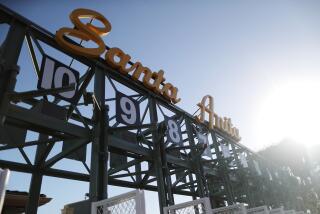Case of Naked Eye vs. Electronic Eye
- Share via
DEL MAR — In its latest communique to the horse-playing public, the Del Mar race track announces it has added to its satellite betting stations the Cabazon Indian Bingo Palace near Palm Springs.
As you know, that precinct occupies a niche of the Colorado Desert where, this time of year, temperatures rise to 120.
The scorching heat parallels that of Saudi Arabia, except troops debarking there aren’t able to find respite in an air-cooled emporium where one combines the thrill of bingo with the science of picking the double.
The Cabazon Indian Bingo Palace is the 13th oasis for off-track wagering on Del Mar races, whose following in the outback, amazingly, exceeds that at the scene.
The president of Del Mar, Mr. Joe Harper, is slightly stunned. He discloses:
“Our last figures show that the satellites not only are drawing more players than the track, but that the per capita betting among satellite players is higher, too.”
Specifically, the average horse player at Del Mar has been sending $177 a day plunging through the machines.
In the hinterlands, the average player is wagering $232.
Del Mar doesn’t appreciate this disparity but understands it. Among those visiting the track, a certain segment is coming mainly for sunshine and lunch.
Also passing through the turnstiles are children who, 12 and under, get in free.
Since such elements bring down the per capita betting at the track, decisive measures on the part of management are called for.
First, it must be established that before anyone is served lunch, he must post a bond guaranteeing he will bet at least $232, matching the average figure off-track.
And second, to deal with children, the betting age must be lowered to 5. With that stroke, the track would be calling the bluff of kids who claim they are willing to bet, but aren’t permitted.
“Is it embarrassing that those who don’t come to the track are betting more than those in attendance?” Harper is asked.
“We are thankful for any interest in our sport,” he answers. “But naturally we do better when players come to Del Mar. We figure, financially, it takes 2 1/2 off-track patrons to make up for one patron at the track.”
By that is meant, the track makes a score when it hits a visitor for admission, parking, food, drink and a program.
On wagering away from the track, the satellite station also shares in the mutuel takeout, reducing the sum normally hauled in by the house.
But satellite wagering is no trendy gizmo, destined to fade. It will remain a serious facet of an industry backsliding at most of its cavalry posts about the land.
The sport is now telling the populace, “If you can’t come to the races, we’ll take the races to you.”
Now we ask Joe Harper a question of vital concern, namely, how much of his science does a bona fide horse player give up betting only by pictures?
For instance, is his presence not required at the scene to monitor, say, a horse committing a nuisance on the track on his way to the post?
TV doesn’t always pick up such delicate nuances, known to swing a bettor onto a horse or off one.
“A screen can’t capture what the human eye can,” Harper says. “Some players will never bet a horse they suspect of being nervous. And how can they tell he is nervous? Often by whether he is sweating when he appears on the track.”
Many times, it is the horseplayer who is sweating, in which case the horse dissuades his backing, not anxious to run for a gambler who is washy.
“Then you have the paddock student,” Harper continues. “Up close, he wants to study the horse and his physical soundness before he risks his money on him. And it is rare that your true racing scientist will bet until he watches the horse warm up. On TV, these things aren’t always clear.”
OK, we now ask Julio Garcia, one of the hottest jockeys on the job today, whether he worries about the plight of the horseplayer. Julio, who comes from Carolina, Puerto Rico, answers:
“I worry only about the horse.”
Julio’s explanation is reasonable.
“One time,” he says, “I take my eye off the horse and he kicks me in the face, breaking my cheekbone. He also gives me sore teeth.”
Watching pictures at the Cabazon Indian Bingo Palace, one wouldn’t necessarily see this, reaffirming that TV racing is all right, but not perfect.
More to Read
Go beyond the scoreboard
Get the latest on L.A.'s teams in the daily Sports Report newsletter.
You may occasionally receive promotional content from the Los Angeles Times.










